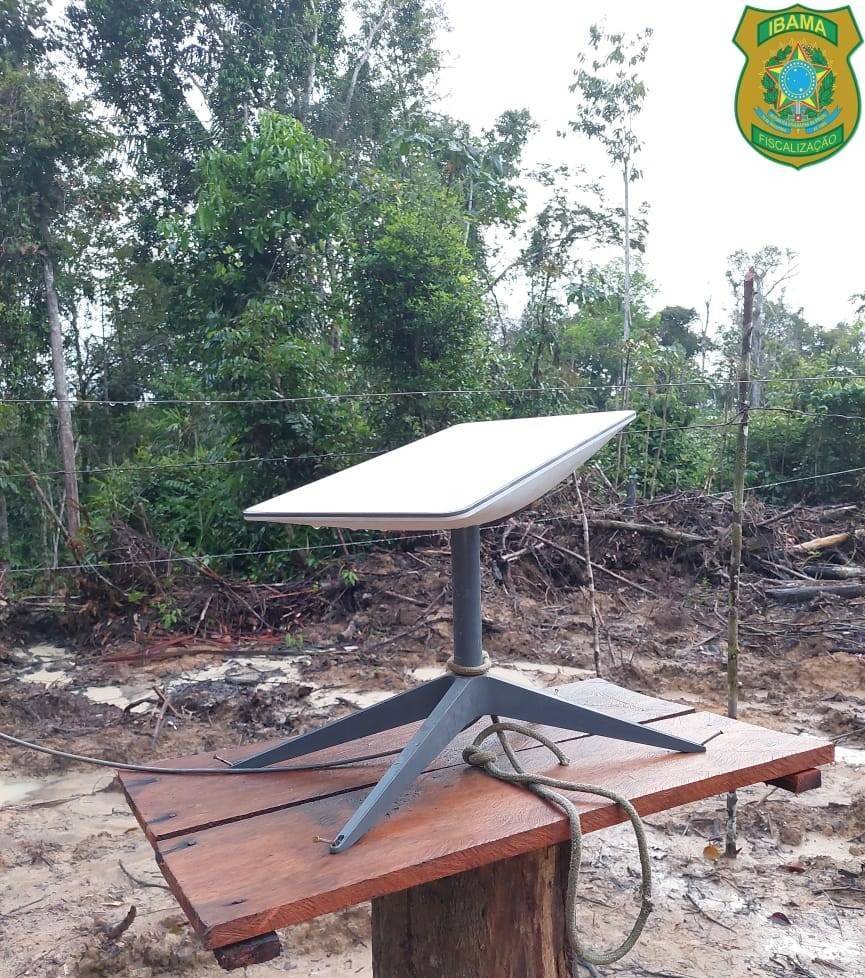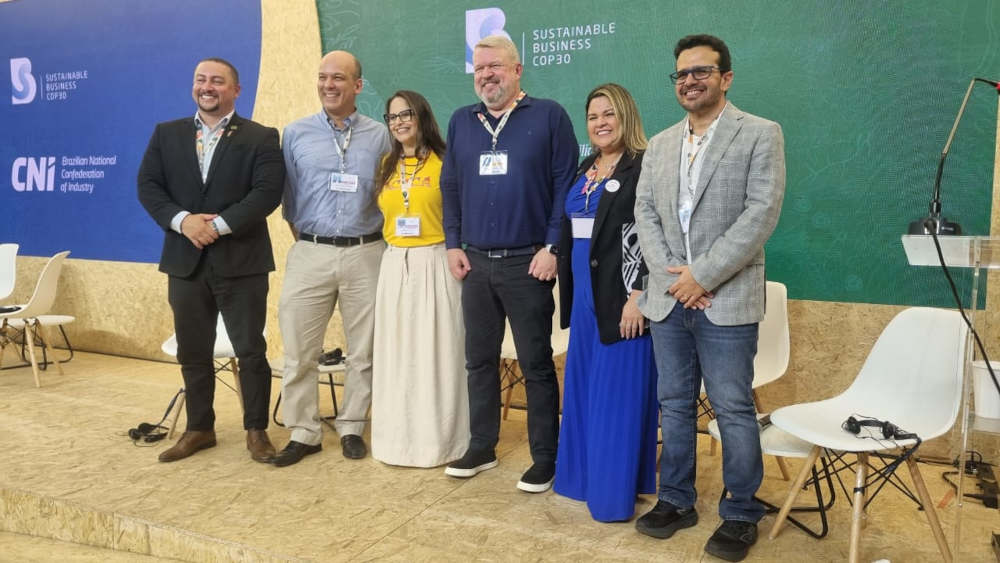A GROUP OF 50 WORKERS in conditions analogous to slavery were rescued in an illegal deforestation area in the south of Amazonas, Brazil. The rescue was one of the largest of the year – second only to an action that found 54 people in a gold mine in Maués, also in the same state.
Those responsible for the deforestation had installed an antenna in the midst of the forest to access the internet through Starlink – a satellite broadband service provided by SpaceX, the company founded by billionaire Elon Musk.
“Today Starlink is one of the biggest bottlenecks for enforcement actions. [Internet access] is a source of requests for supplies and warnings that enforcement is coming for miners and deforesters,” says Jonathan Paixão dos Santos, an environmental agent from the Brazil’s Environment agency Ibama.
Repórter Brasil contacted Starlink to inquire if the company has any mechanism for controlling equipment sales and internet signal use in illegal activities. The company had not responded. The space remains open for comments.

The inspection occurred in the rural area of Manicoré in Amazonas, in a traditional territory of 15 riverside communities granted through a Concession of Real Right of Use.
The workers were operating chainsaws to cut down trees. It was the largest deforestation detected by Ibama in the state of Amazonas since the beginning of the year.
The rescued people had been in tarpaulin shacks for over a month and had no access to drinking water. They cooked, bathed, and drank water from a nearby stream. João*, one of the workers, described the water as “red and tasted like rotten leaves”. He is one of the 50 rescued in the operation. The workers lacked safety equipment, and one of them fractured his collarbone after being struck by a tree branch.
The destruction of the forest was progressing at the rate of 10 hectares a day. In 2024 alone, 1,300 hectares of forest have been felled. Since 2022 there have been 3,700 hectares of deforestation.
“I’ve never seen anything like this in terms of the size of the deforestation and the number of workers. It’s very aggressive and there has to be a response from the State,” said Magno Riga, the labor inspector who coordinated the operation on May 24.
“They didn’t give us any protective equipment. The job is very risky. Trees fall everywhere,” says João. He was born in the Amazonian town of Apuí. The worker is experienced in cutting down the forest, but was surprised by the number of people hired for the megadeforestation: “With more people, it’s riskier, you work close to each other. When a tree falls, it can knock down another one in front of it and cause an accident. It’s too dangerous,” he said.
The workers have already been sent to their hometowns in Amazonas and Rondônia. Lucinei Soares da Vitória has been identified as the manager responsible for the activity. His lawyer said he had no interest in commenting on the operation.
Investigations are ongoing to determine if there are other individuals involved.
The operation to rescue the workers was coordinated by the Ministry of Labor and Employment and Ibama and included the participation of the Federal Police and the Labor Prosecutor’s Office.

Cattle and land grabbing
More than 12 chainsaws were destroyed in the lodge where the rescue happened. Fuel tanks, a freezer, and a power generator were also found there. “There are more than 30 chainsaws [in the forest] that we can’t access,” says Santos, from Ibama.
The chainsaw operators were instructed to cut down the trees “well trimmed to make pasture”, says João. This type of deforestation is known as “clear-cutting”, a method that cuts down most or all of the trees in the way.
The inspector warned that those who invaded the area would try to grab the land and cattle in the future.
In March, river dwellers spotted a ferry with four tractors and excavators on the Manicoré River, according to Amazônia Real. Since 2022, they have been denouncing logging in the region, which has been emerging as a new front for deforestation.
Deforestation has already destroyed Brazil nut and açaí trees in communities along the Manicoré River.
“The forest has copaiba, vines, straw, and game that people harvest for their livelihoods. We need the forest standing. If it’s cut down, what will happen? How will future generations survive?” warns a community leader who preferred not to be identified.
Muddy water
João says that the journey from Apuí to Manicoré was difficult. Lured by the promise of earning up to US$160 a day as a chainsaw operator, he faced the road and river journey to the deforestation front. On the last stage by water, the most painful, he and 26 other people traveled for 14 hours up the Manicoré River in a boat with capacity for only 15: “people were sleeping on the roof of the boat,” he recalls.
The workers had to travel 8 kilometers on foot or by tractor to their lodgings. João was told that the daily rate would be reduced when he arrived. The value of the chainsaw – around US$ 580 – would also be deducted from the final payment. The equipment was destroyed by Ibama and he didn’t have to pay.
João also says that the first few days the stream was clear, but as the deforestation progressed towards the springs, the water became muddy, and “people started getting stomach aches”.
The inspectors also found women and children who were accompanying their family workers. There were three women, who worked as cooks, and a 16-year-old teenager. The youngster was the son of one of the employees and worked as a helper in the chainsaw operation, contrary to a Brazilian decree that prohibits minors from working in timber extraction, as it is considered an activity that is harmful to health and safety.
Southern Amazonas under pressure
Deforestation is also putting pressure on the riverside communities of Humaitá, also in the state of Amazonas, 1500 kilometers from Manicoré on the Madeira River.
Cattle and timber extraction are driving the clearing of the forest and the invasion of family farming settlements there. Deforestation has already impacted a hundred conservation units and indigenous lands in the area of influence of the BR-319 highway, which connects the Amazonian capital Manaus to Porto Velho (RO). In February of this year alone, 700 hectares were cleared near the highway.
“Our chestnut grove is all gone. Wherever we went there was water and we encountered all kinds of animals. Today, we can no longer find game to kill, to eat,” laments Valdino Mota, a farmer who lives in the Santa Rita community, also known as Pirapitinga, one of the localities facing the advance of deforestation in the region.
Pressured by the loss of territory and without a job option, some riverine farmers are already clearing areas for pasture. Repórter Brasil went to the region and spoke to two people who worked in the forest and both reported poor conditions of accommodation, food, and safety during their work.
Without the forest, swiddens, açaí, or Brazil nuts, the communities fear for the future. “If we don’t stop them [invaders], it will end, the slave era will return,” said one river dweller, on condition of anonymity.
*Fictitious name to preserve the worker’s identity
Leia também


